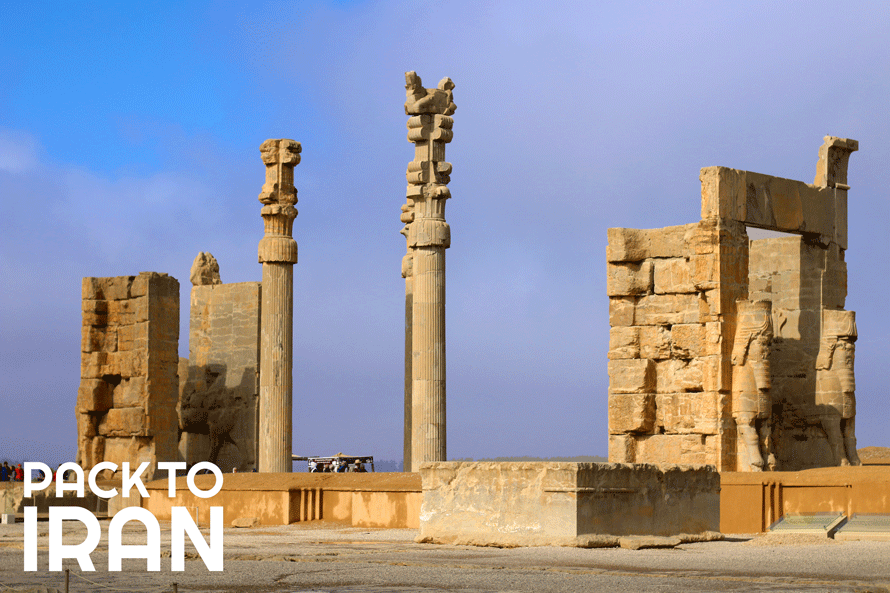Persepolis, (also known as Takht-e Jamshid, Parseh or Sad Sotun) is one of the ancient cities in Iran which was the glorious and ceremonial capital of Persia during the Achaemenid Empire. Persepolis is the famous monument in Iran, and one of the top attractions that every traveler should definitely visit in Iran, as it is one of the most important legacies left from the anciet civilizations of the world. The day of visiting Persepolis is usually the most important day on tours of Iran about which travelers are excited.
The history of Persepolis
The construction of the complex of Persepolis Palace, also known as Takht-e Jamshid was started in 518 BC. by the order of Darius, I, and then continued by adding new buildings during the reign of his son Xerxes I and his grandson Artaxerxes I. This great complex was the ceremonial palace of the Achaemenid kings for 200 years, where they celebrated Nowruz (Iranian new year) and accepted guests who brought presents from other nations. Although in 330 BC., Alexander the great invaded Iran and burnt down the royal city of Persepolis, the ruins are still one of the most amazing attractions left from the ancient world. This historical monument was registered as a UNESCO World Heritage Site in 1979.
Construction of Persepolis
Persepolis is located in the center of Fars Province, 60 kilometers away from Shiraz, in the north of Marvdasht Town. This is built on an 18-meter stone platform on the slopes of Rahmat Mount. This 125000 square meter area is 455*300*430*390 meters. One of the significant traits of Persepolis is the golden ratio of arches, and the pillars, which show the mesmerizing talent of the architects and artists who built this construction. These experts where from Iran and other nations like Assyria, Egypt, Babylon, India, and Urartu. In spite of disasters like earthquake, many of the pillars and arches in Persepolis are still standing until today, and this stability is the result of genius methods like using melted lead or dovetail joint for assembling different pieces of stones.
Some parts of this vast ancient site are described below:
-
The Gate of All Nations
After passing the two symmetrical stairways each with 111 stairs you’ll reach a great entrance gate which is assigned to the Xerxes. This gate is 10 meters high and is characterized by the legendary sculptures of two Sphinxes and two guardian giant bulls. This palace was actually an entrance where all delegations of different nations which were subjected to the Persian Empire were welcomed to the Persepolis.
|
|
| Gate of All Nations - Persepolis, Iran |
-
Apadana Palace
Apadana Palace or the Audience Palace is one of the oldest constructions of the Persepolis, where Darius I and Xerxes celebrated Nowruz ceremony and accepted thousands of guests. Apadana is a great 560*560 meters’ square area with three ivans (porches) each with 12 columns. There are two stairways on the east of Apadana palace, which are known for having the most amazing bass reliefs and ornaments. The stairway leading to the north shows commanders from Mede and Persia holding water lilies and the members of Persian immortals tributing them. The stairway leading to the south pictures ambassadors who are bringing presents from different nations and the symbolic bass relief of a lion and bull combat.
|
|
| Apadana Palace - Perseplis, Iran |
-
Tachar Palace
Acoording to an inscription, Tachar is the private winter palace of Darius I. This palace is constructed on a 2.5-meter-high platform and has 12 columns. The arcs are ornamented with bass reliefs picturing the king and two companions holding a canopy over his head. The bass reliefs on the stairway show servants carrying animals and dishes for holding a ceremony.
|
|
| Tachar Palace - Presepolis, Iran |
-
Hadish Palace
Hadish Palace which is located on the loftiest spot of Persepolis platform, is assigned to Xerxes and his wife. It is believed that the big fire which ruined Persepolis was started from this palace, therefore a little is left for explore. This palace includes a central hall which has 36 columns and a porch with 12 columns. This hall also has tri-lingual inscription written by Xerxes.
|
|
| Hadish Palace - Presepolis, Iran |
-
Sad Sotun Palace
Located in the esat of Apadana palace, Sad Sotun or hundred columns is the second largest palace in Persepolis, and was named so because of the hundred 14-meter-high columns (10*10) in its central hall. According to a Babylon inscription the construction of this 4300 meters in square palace was started by Xerxes and finished by his son Artaxerxes. A bass relief in Sad Sotun palace shows the battle of king with lion and beast and another one shows the battle of king with the bull.
|
|
| Sad Sotun Palace - Persepolis, Iran |
-
The tombs
There are six tombs available in this area, which are related to the Achaemenid kings. Four of the tombs which are related to Darius I, Xerxes, Artaxerxes I, and Darius II, are in Naqsh-e Rustam ancient site which is 10 kilometers away from Persepolis, and the tombs of Artaxerxes II and Artaxerxes III are located in Persepolis complex. These tombs are cross-shaped rock constructions which are dug into the hill, and are ornamented with bass reliefs showing Farvahar, the symbol of Zoroastrianism with Achaemenid soldiers marching below it.
|
|
| The Tomb of Artaxerxes - Persepolis, Iran |
Visiting Persepolis
As mentioned above, no trip to Iran would be complete without visiting Persepolis and learning about its architecture and bass reliefs. For a good tour of Persepolis and visiting it completely, you need to start your 60-kilometer road trip from Shiraz around 8 in the morning. An important note that should be considered is that the visitors are not allowed to enter Persepolis with a backpack or a big bag and also, since visiting Persepolis takes a lot of walking under the sun, wearing sunscreen and comfortable shoes suitable for long walks is highly suggested. VWhether you get an Iran tour or travel individually, we highly suggest that you visit Persepolis accompanied by a guide so that you don’t miss the amazing facts and information about the history, legends, and the meaningful motifs of this ancient world heritage.Therefore, PackToIran has designed a Necropolis and Pasargadae Day Tour so that individual travalers have the option to explore the three Achaemenid ancient sites in one day.








